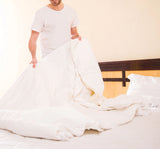How spring clean your bed
 It’s the time of year to clean things up at home – and that includes in the bedroom. You spend more hours a day in bed than anywhere else, so it’s a good idea to make sure it’s getting some attention during your spring cleaning. Here’s our guide on how to make sure you’re sleeping fresh:
It’s the time of year to clean things up at home – and that includes in the bedroom. You spend more hours a day in bed than anywhere else, so it’s a good idea to make sure it’s getting some attention during your spring cleaning. Here’s our guide on how to make sure you’re sleeping fresh:
It starts with the bedding
Experts suggest changing your sheets and pillowcases every week, since they are full everything we shed during sleep. For blankets, duvet covers, and comforters, try to clean them every month, or every other month. To get cleaner bedding, don’t overload your washer and wash each type of bedding separately from other items. Cotton sheets and covers are usually safe to wash on any cycle, but make sure to check the tags for specific instructions. If you’re worried about germs, wash on the hottest cycle if your fabric allows to kill any microbes and allergens.Be aware – some fabrics don’t react well to hot temperatures. If you have an electric blanket, be very careful and follow the instructions. Never put an electric blanket in the washing machine unless it has a detachable cord. Even then, only wash it for a short period of time (about 3-5 minutes), and dry for only 5-10 minutes in the dryer before hanging it out.
Drying bedding on a clothesline is not only environmentally friendly, it’s also healthy. Sunlight is a natural disinfectant, and can brighten up whites. Heavier bedding should still be dried in the dryer, since it can take a long time to air dry, which might lead to mildew. You can dry them for a shorter time, and then finish on the clothesline for the natural benefits.
Freshen your pillow
Pillows need to be washed less often. As long as you’re keeping a pillowcase on you can wash them just twice a year. To improve your pillow, fluff it daily and hang it outside on a sunny day once a month.There are many different kinds of pillows, and each will have specific washing instructions, so check the tag first. Down and fiber pillows can be washed on a gentle cycle in your washing machine with an extra rinse to make sure the water goes through the dense material. Foam pillows should not be put into the wash. It’s better to spot clean or hand wash them. To avoid doing this, instead wash the cover that usually goes over the foam.
Make sure you dry thoroughly. Pillows are dense and can remain damp in the center, which can lead to mold.
Clean your mattress and mattress covers
You might have a mattress protector or encasement or a mattress topper on your mattress. They protect the mattress, but need to be washed every three months. Stick with cooler water for these.After you’ve taken off any coverings, there’s the mattress itself. It’s too big to clean easily, but all the other layers should help protect it. When you change your sheets, use your vacuum on all sides of your mattress to get rid of dust and anything else that may have settled in. It’s best not to use cleaners or a lot of water on your mattress. Chemicals can damage the foam, and water will soak into a mattress and take too long to dry before mildew sets in.
You can disinfect the mattress by lightly misting it with a spray. This can also help remove odors. Gently rubbing baking soda into the mattress and letting it sit for about an hour before vacuuming it up can also help with odors and stains. It’s not good to rub in essential oils to your mattress, since they can stain.
It helps to flip the mattress every 3-6 months.
Removing stains
Unfortunately it’s not economical to buy new bedding every time there’s a stain. Pre-treat stains on your sheets before you wash them. You can use bleach, but keep in mind it will break down the fabric faster.On a mattress, you can treat spots with a stain remover. For a large stain, mix powdered detergent with a small amount of water to form a paste. Apply to the area and let sit for 15 to 30 minutes before wiping clean. Dry thoroughly, then vacuum up any leftover dried paste.
Specific stains can be removed using regular materials you likely have around your house. Fresh blood can be removed with cold water, a little soap, and a rag. For older blood stains, you need hydrogen peroxide, dish soap, and salt.
With urine, if fresh, blot it dry and sprinkle the spot with baking soda. Let it dry for 20-30 minutes then vacuum. With older stains, mix baking soda, hydrogen peroxide, and liquid dish soap. Exact recipes and instructions can be found on many sites, like here.
The bed itself
What supports your mattress and bedding should be cleaned as well. This includes any box spring, platform, slats, headboard, or footboard you might have. Because you’re not sleeping directly on these, they can be cleaned less frequently. You can vacuum the box spring at the same time you vacuum the mattress, but about once a year it’s a good idea to do a more thorough cleaning.Remove the mattress and take off any dust ruffle to clean as you would sheets. Then vacuum the box spring on all sides. Treat any stains and set out to dry. Next, any metal foundation should be wiped off with a damp cloth to remove any dust and debris. Follow with a dry cloth to remove the moisture and any remaining dust. This is also a good method for wood slats – just make sure not to get them too wet.
Headboards, footboards, and side rails should be cleaned according to their material. For wood furniture, use a polish and a wood-safe disinfectant wipe. With upholstery, vacuum and steam cleaning are usually safe. You can usually use a disinfectant spray without worrying.
This is also a good time to check everything and make sure it’s in good working order. If you need a new mattress, box spring, or foundation, we can deliver right to your door.

